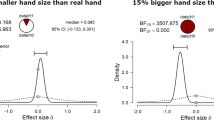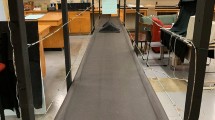Abstract
IT is widely accepted1 that, in their drawings, children below the ages of 8 or 9 years typically disregard the conventional rules whereby depth is represented in perspective. Piaget and Inhelder2 argue that, in order to represent an object in perspective, the artist must recognize that both the object and observer occupy the same projective space extending beyond the object and including the observer as well. Children cannot adopt the objective viewpoint necessary to recognize this, therefore they cannot draw in perspective. Because this viewpoint need not be adopted when interpreting perspective drawings, children have no difficulty perceiving pictures in depth. This argument can be questioned. Young children may not draw in perspective because they cannot even perceive depth in pictures, quite apart from portraying it in their own drawings. Hudson3,4 found that European children, during their first year at school, were like unacculturated African tribal adults in that many failed to interpret the perspective features of a picture as representing depth. Other cross-cultural studies, like those of Hudson5, Deregowski6 and Winter7, indicate that the interpretation of pictures in depth is a learnt ability that requires a considerable amount of practice. Subjects that have had little exposure to pictorial material experience difficulties when interpreting pictorial depth.
This is a preview of subscription content, access via your institution
Access options
Subscribe to this journal
Receive 51 print issues and online access
$199.00 per year
only $3.90 per issue
Buy this article
- Purchase on Springer Link
- Instant access to full article PDF
Prices may be subject to local taxes which are calculated during checkout
Similar content being viewed by others
References
Eng, H., The Psychology of Children's Drawings: from the First Stroke to the Coloured Drawing (Routledge and Kegan Paul, London, 1954).
Piaget, J., and Inhelder, B., The Child's Conception of Space (Routledge and Kegan Paul, London, 1956).
Hudson, W., J. Soc. Psychol., 52, 183 (1960).
Hudson, W., Psychologia Africana, 9, 226 (1962).
Hudson, W., Int. J. Psychol., 2, 89 (1967).
Deregowski, J. B., Brit. J. Psychol., 59, 195 (1968).
Winter, W., Psychologia Africana, 10, 127 (1963).
Gibson, J. J., The Perception of the Visual World, 182 (Houghton Mifflin, Boston, 1950).
Jahoda, G., Brit. J. Psychol., 57, 193 (1966).
Gregory, R. L., Nature, 199, 678 (1963).
Gregory, R. L., Quart. J. Exp. Psychol., 19, 219 (1967).
Author information
Authors and Affiliations
Rights and permissions
About this article
Cite this article
NEWMAN, C. Children's Size Judgments in a Picture with Suggested Depth. Nature 223, 418–420 (1969). https://doi.org/10.1038/223418a0
Received:
Revised:
Issue Date:
DOI: https://doi.org/10.1038/223418a0
Comments
By submitting a comment you agree to abide by our Terms and Community Guidelines. If you find something abusive or that does not comply with our terms or guidelines please flag it as inappropriate.



